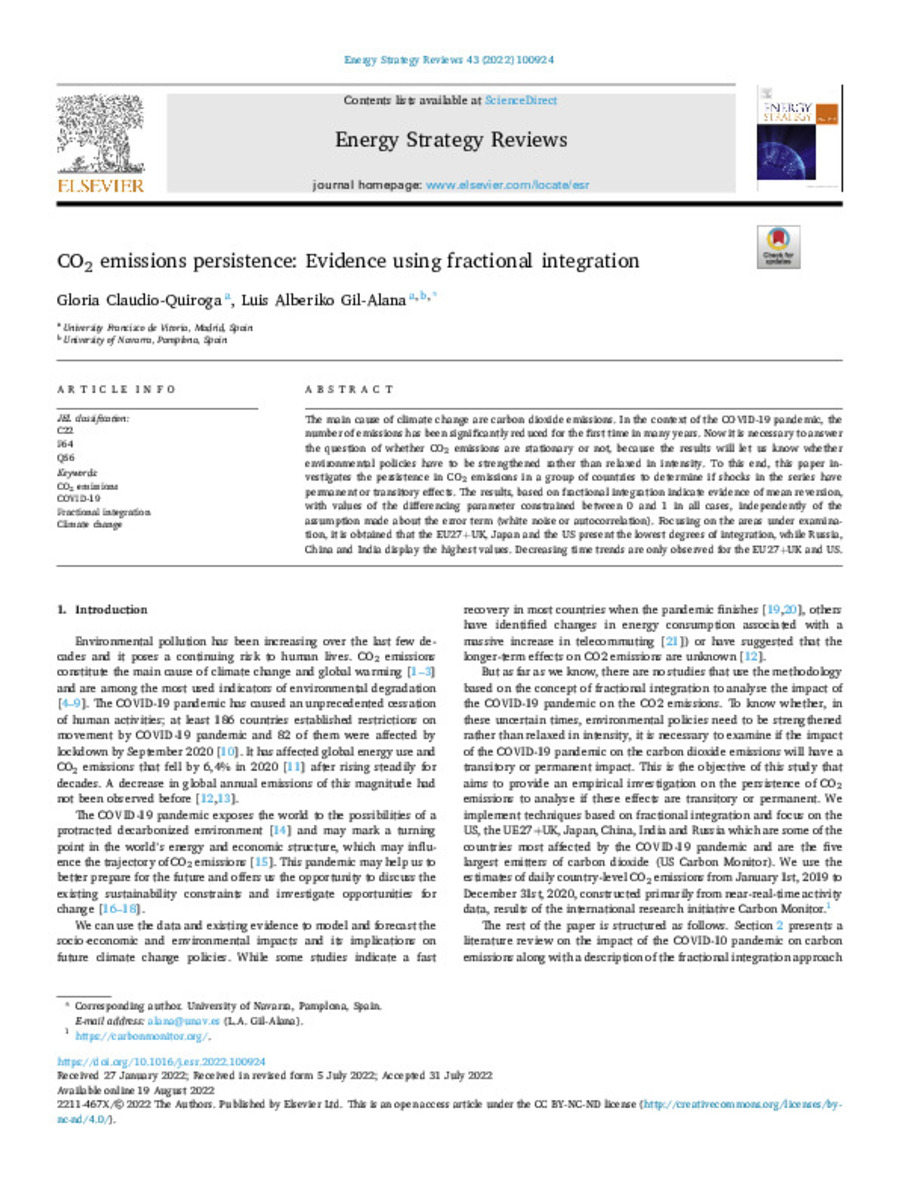Full metadata record
| DC Field | Value | Language |
|---|---|---|
| dc.creator | Claudio-Quiroga, G. (Gloria) | - |
| dc.creator | Gil-Alana, L.A. (Luis A.) | - |
| dc.date.accessioned | 2023-04-26T12:32:21Z | - |
| dc.date.available | 2023-04-26T12:32:21Z | - |
| dc.date.issued | 2022 | - |
| dc.identifier.citation | Claudio-Quiroga, G. (Gloria); Gil-Alana, L.A. (Luis A.). "CO2 emissions persistence: Evidence using fractional integration". Energy Strategy Reviews. 43, 2022, 100924 | es_ES |
| dc.identifier.issn | 2211-4688 | - |
| dc.identifier.uri | https://hdl.handle.net/10171/66121 | - |
| dc.description.abstract | The main cause of climate change are carbon dioxide emissions. In the context of the COVID-19 pandemic, the number of emissions has been significantly reduced for the first time in many years. Now it is necessary to answer the question of whether CO2 emissions are stationary or not, because the results will let us know whether environmental policies have to be strengthened rather than relaxed in intensity. To this end, this paper in- vestigates the persistence in CO2 emissions in a group of countries to determine if shocks in the series have permanent or transitory effects. The results, based on fractional integration indicate evidence of mean reversion, with values of the differencing parameter constrained between 0 and 1 in all cases, independently of the assumption made about the error term (white noise or autocorrelation). Focusing on the areas under examina- tion, it is obtained that the EU27+UK, Japan and the US present the lowest degrees of integration, while Russia, China and India display the highest values. Decreasing time trends are only observed for the EU27+UK and US. | es_ES |
| dc.description.sponsorship | Both authors gratefully acknowledge financial support from the MINEIC-AEI-FEDER PID2020-113691RB-I00 project from ‘Ministerio de Economía, Industria y Competitividad’ (MINEIC), ‘Agencia Estatal de Investigaci ́on’ (AEI) Spain and ‘Fondo Europeo de Desarrollo Regional’ (FEDER). They also acknowledge financial support from internal Pro- jects of the Universidad Francisco de Vitoria. L.A. Gil-Alana and G. Claudio-Quiroga have contributed equally to all aspects of the research. The datasets generated during and/or analysed during the current study are available in the Carbon Monitor (data available at https://carbon monitor.org/). | es_ES |
| dc.language.iso | eng | es_ES |
| dc.publisher | Elsevier | es_ES |
| dc.relation | info:eu-repo/grantAgreement/AEI/Proyectos I+D/ PID2020-113691RB-I00/ES/INTEGRACION FRACCIONAL: AVANCES TEORICOS Y DESARROLLOS EMPIRICOS | es_ES |
| dc.rights | info:eu-repo/semantics/openAccess | es_ES |
| dc.subject | CO2 emissions | es_ES |
| dc.subject | COVID-19 | es_ES |
| dc.subject | Fractional integration | es_ES |
| dc.subject | Climate change | es_ES |
| dc.title | CO2 emissions persistence: Evidence using fractional integration | es_ES |
| dc.type | info:eu-repo/semantics/article | es_ES |
| dc.description.note | This is an open access article under the CC BY-NC-ND license | es_ES |
| dc.identifier.doi | 10.1016/j.esr.2022.100924 | - |
| dadun.citation.publicationName | Energy Strategy Reviews | es_ES |
| dadun.citation.startingPage | 100924 | es_ES |
| dadun.citation.volume | 43 | es_ES |
Files in This Item:
Statistics and impact
Items in Dadun are protected by copyright, with all rights reserved, unless otherwise indicated.






